Have you heard of this game? Whether you have or not, here’s my review of Hanabi!
Hanabi is a cooperative card game where you can’t look at your own cards and need the help of the other players to figure out what they are before playing them. The goal is to complete different colored stacks in order from one to five. It’s a great game that requires players to really think about what they’re doing.
Table of Contents
Hanabi Overview
Hanabi is a little cooperative card game that’s been around since 2010. By the way, Hanabi means “Fireworks” in Japanese. Pretty cool. That said, here are the rest of the back-of-the-box facts about Hanabi.
Back-Of-The-Box Facts About Hanabi
- Player Count: 2-5
- Time To Play: 30 minutes
- Age Range: 8 and up
- Difficulty: Intermediate/Medium
- Price Range: $8-$15
- Release Year: 2010
- Publisher(s): R&R Games
- Designer(s): Antoine Bauza
- Artist(s): Antoine Bauza, Albertine Ralenti, and Gérald Guerlais
- Where To Buy: Amazon
What Comes In The Box?

With Hanabi, you’ll get 60 cards in six colors: red, yellow, green, white, blue, and rainbow. Each color comes with three ones, two twos, two threes, two fours, and one five.
There are also eight clock tokens (I call these clue tokens) and four fuse tokens. There’s the rulebook too.
Theme

The “theme” in Hanabi is that you’re fireworks technicians. Somebody jumbled up all the fireworks before the big show though, so you all have to work together to put the fireworks back together!
How To Play Hanabi
Hanabi is the definition of a simple game to learn but one that’s difficult to master, but let’s talk about setup before we get to all of that.
Setup
To set up Hanabi, you shuffle all the colors together except for the rainbow cards (those are only included in the advanced versions of the game, which I don’t recommend playing unless you’re experienced with Hanabi), then put them in a facedown deck in the center of the table.
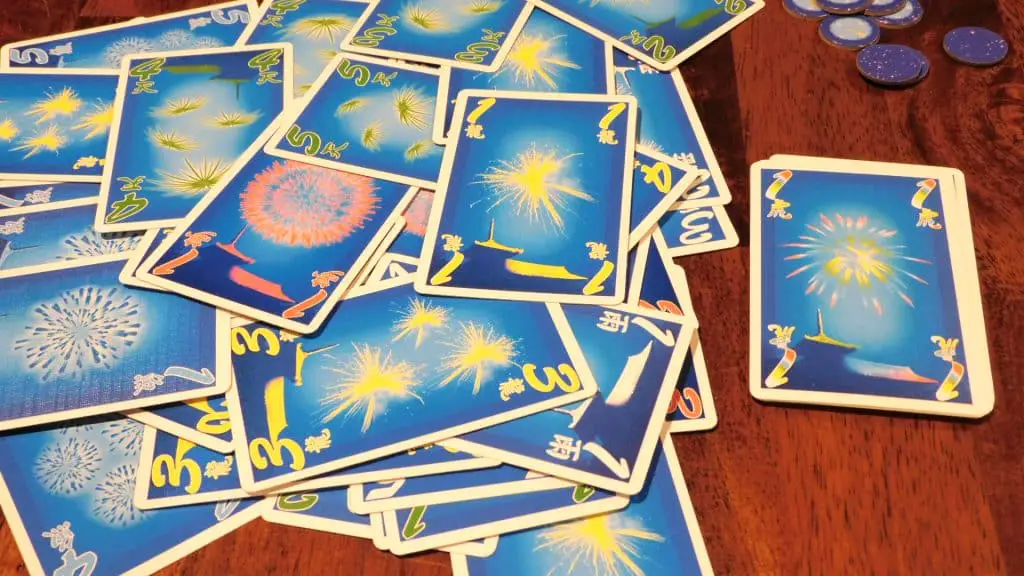
If there are two or three players, give each player five cards. If there are four or five players, give each player four cards.
Take the clock (clue) tokens and also set them in the center of the table. Stack the fuse tokens on top of each other with the longest fuse on top.
Now, you’re ready to play Hanabi!
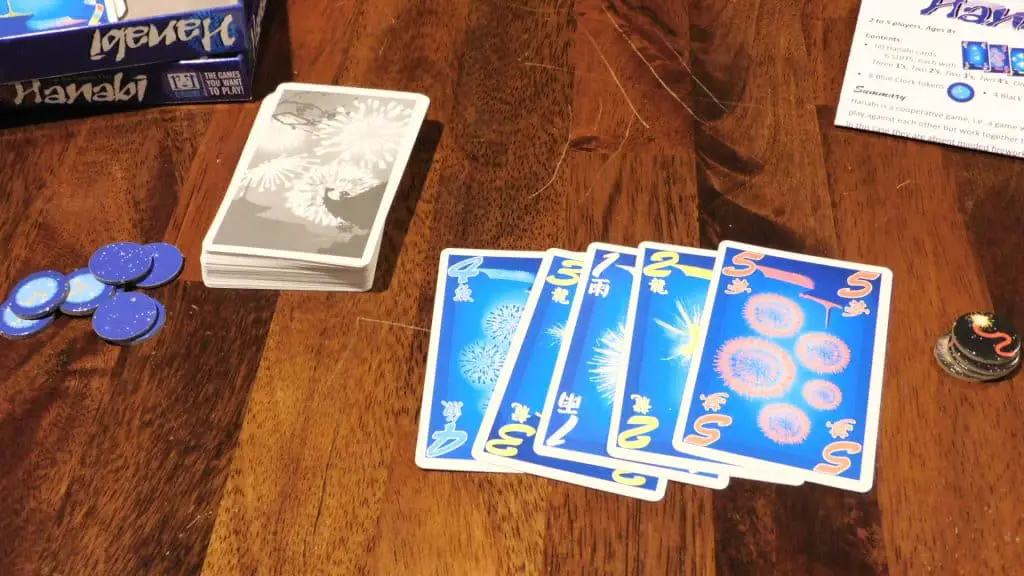
What Players Do On Their Turns
On a player’s turn, they can do one of three things: play a card, discard a card, or give someone a clue about their cards.
Since you can’t see your cards, playing a card means hoping you’ve deduced correctly what that card is based on your teammates’ clues and what’s already been played or discarded.
When you play a card, one of two things can happen. Either it ends up being the next number for a certain color stack or it doesn’t. If it is, it goes on the stack. If it doesn’t, it goes to the discard pile and a fuse counter is removed.
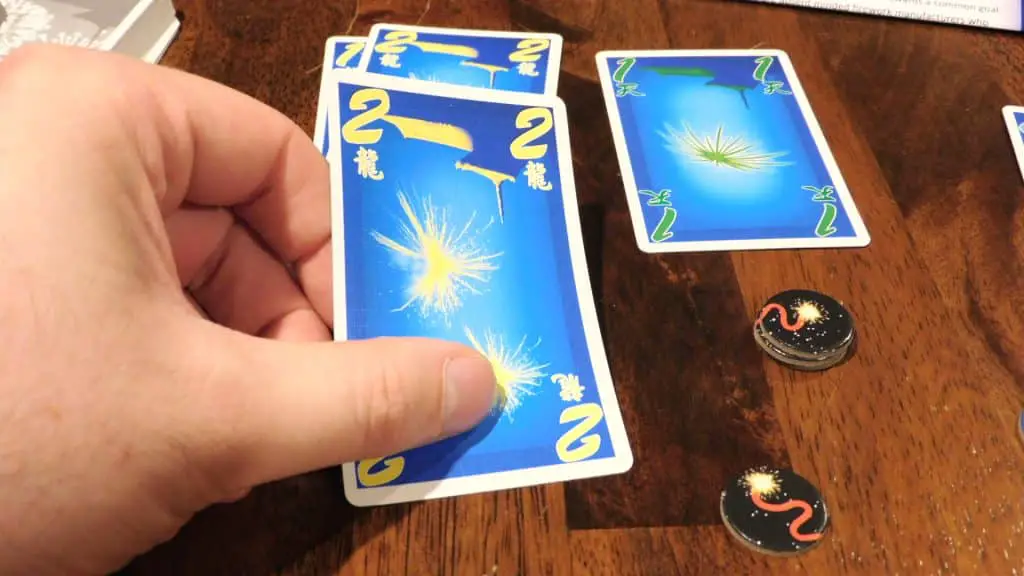
Discarding a card will get you a clue token back. Giving someone a clue about their cards uses a clue token. You have to tell them all the cards of one color or one number in their hand.
How To Win Or Lose
All players win or lose Hanabi together. You win by correctly making a stack of one to five in each color.

If you do, your score is Legendary, according to the rules. You’ll still get a rating for anything less than that, you’ll just have to count the cards you laid down, keeping in mind each card counts as one point, then check your score against the rules.
You lose Hanabi if you have to remove three fuse tokens.
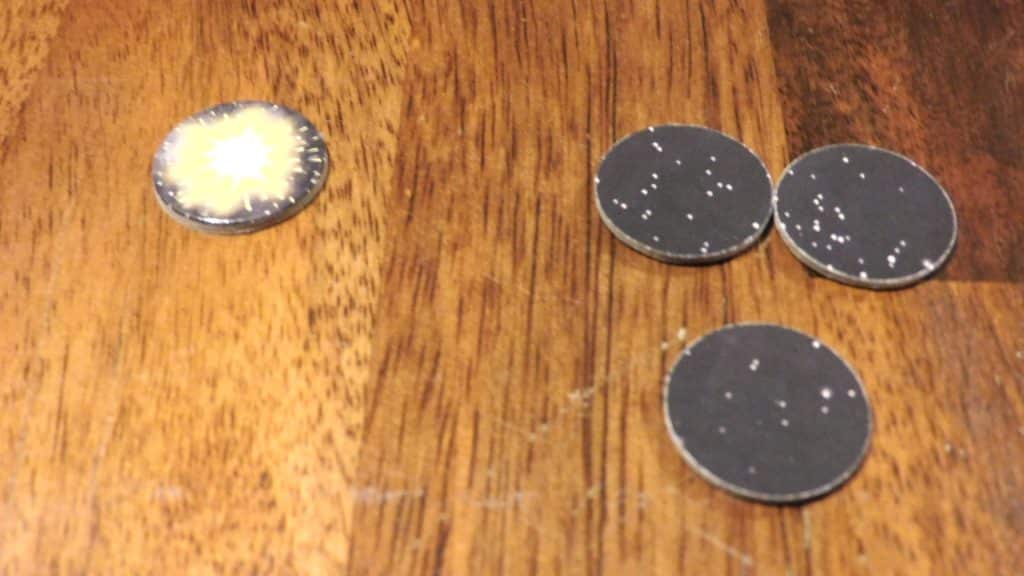
Hanabi Review
And now it’s time for the review! Let’s start with the art.
Art
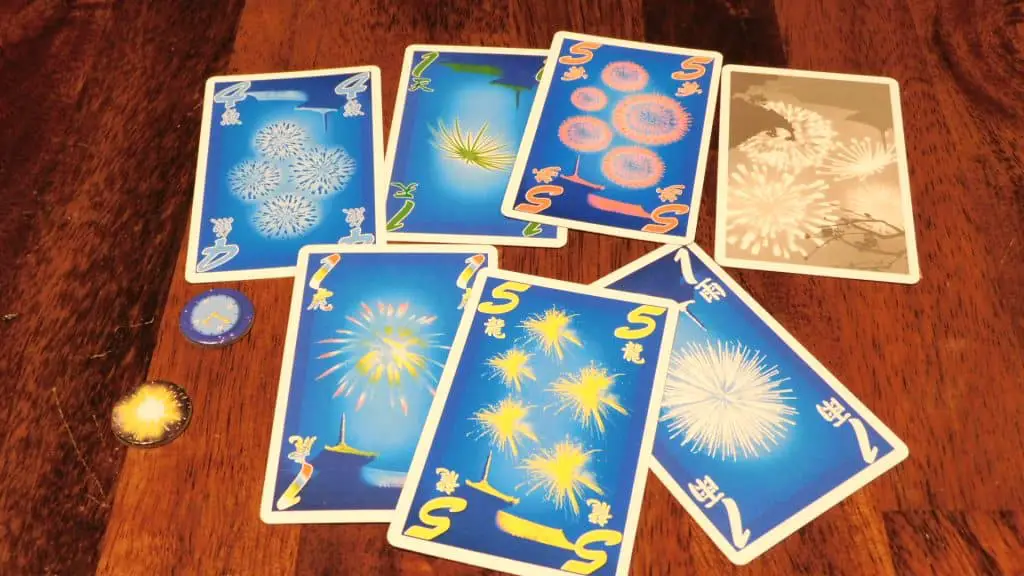
Hanabi’s art is colorful and can be clearly understood. It’s nothing special, but it accomplishes what it sets out to do.
Components
The tokens are okay quality, but they’re not the important components here. The cards are what’s important in Hanabi, and, thankfully, they are of great quality. They have rounded corners and are a linen finish. Great cards all around.
Theme
I mentioned the theme above, but it really doesn’t come through in Hanabi. It’s an interesting theme, to be sure, but you won’t ever think you’re trying to organize fireworks. You’re playing a card game, nothing more.
Gameplay
The gameplay is awesome in Hanabi. It’s so interesting not being able to see what your cards are and having to trust your teammates’ clues, what’s already been played, and yourself.
The only downside is because the game does require a fair amount of strategy, folks who suffer from analysis paralysis will struggle with it. That aside though, turns go relatively fast, the game is easy to understand, and you’re always interested in what’s going on.
Replayability
Having never beaten Hanabi, it’s difficult for me to see if it would still feel replayable after beating it. However, I have played it a lot, and I’ve enjoyed playing it each and every time. It hasn’t felt stale once, so I’d say it’s pretty replayable.
Even after beating it, I imagine the next challenge would be doing it again or taking on the advanced mode.
Hanabi: My Rating
Oh, Hanabi’s a Buy, for sure.
For those who don’t know, I rate games on a scale of Don’t Buy, Wait For A Sale, and Buy. I bought Hanabi long ago, and I haven’t regretted it since.
This game won’t be for everyone. I get that, but it’s a game experience I have yet to see replicated in another.
I’ve played plenty of cooperative games, and plenty of card games, and I’m sure I’ve played some cooperative card games even though I can’t think of them right now. And here’s the thing, I still want to play Hanabi.
It’s not just that I’ve never beaten the game, it’s that it’s such a unique experience! Very few games don’t let you look at your own cards. Very few games make you sweat (in a good way!) the WHOLE time you’re playing.
That’s because no matter how good you are at giving clues, no matter how good you are at deducing what’s in your hand, you never really know! So, when you make a decision to discard a card or play a card, and the other players suck in their breath in anticipation or dread, you’re left wondering, Am I making the right choice here? Did I make a mistake?
Even when you know you’ve made the right choice, no one can give you any hints otherwise! They will suck in their breath, but only when you announce your action for the turn, not as you’re picking a card to do that action with.
Hanabi is one of the greatest bait-and-switch games in all of board gaming history. It makes you think it’s going to be a fun little card game when in reality it is fun, but it’s also quite challenging.
And the fact you get RATED at the end of each session is killer. Sometimes you know you’ve done poorly, so you don’t even have to look. Other times, as you’re counting up your points, you’re hoping, just hoping they’ll add up to something great.
So, if this kind of experience sounds up your alley, I highly recommend Hanabi to you.
Did You Know?
(Each time you refresh the page you will get a new “Did You Know” fact!)
Did you know there’s such a thing in board gaming as an alpha gamer? If not, let me direct you over to this article that explains this all-important term. Thanks for reading!
Conclusion: Hanabi Review
So, what do you think of Hanabi now that you’ve read through my review? Are you more interested or less? Let me know your thoughts and why in the comments below!
And, as always, keep on gaming, fellow board gamers.

